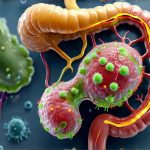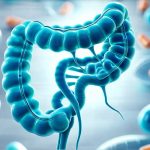Antibiotics are life-saving medications, undeniably crucial in combating bacterial infections. However, their broad-spectrum nature—killing both harmful and beneficial bacteria—often disrupts the delicate ecosystem within our gut, known as the microbiota. This disruption can lead to a range of uncomfortable side effects, from digestive issues like diarrhea and bloating to more systemic impacts on immunity and overall well-being. Rebuilding this microbial community isn’t about instantly repopulating it with specific strains (though probiotics can play a role); it’s about creating an environment where beneficial bacteria can thrive and naturally re-establish themselves, supported by the right nutritional choices. The process is gentle, gradual, and focuses on nourishing the existing survivors and encouraging their growth alongside newly introduced helpful microbes.
The gut microbiota isn’t just about digestion; it profoundly influences our immune system, mental health, and even hormone regulation. After antibiotic use, this intricate network can become unbalanced, a state known as dysbiosis. The consequences of dysbiosis extend beyond immediate discomfort. A compromised gut barrier—often resulting from microbial imbalance—can contribute to increased inflammation, nutrient malabsorption, and potentially chronic disease over time. Therefore, proactively supporting gut health post-antibiotics isn’t merely about alleviating symptoms; it’s an investment in long-term wellness. This is where the strategic use of functional foods – those offering benefits beyond basic nutrition – becomes incredibly valuable. You may also need to consider how to rebuild your microbiome after antibiotics to help kickstart recovery.
Nourishing a Recovering Gut: The Foundation of Functional Foods
Functional foods are essentially food choices that provide extra health benefits beyond their inherent nutritional value. They aren’t magic bullets, but rather powerful tools to support our bodies’ natural healing processes. For gut microbiota rebuilding, the focus isn’t on finding specific “superfoods” but on incorporating a variety of foods that contribute to overall microbial diversity and resilience. This means prioritizing foods rich in prebiotics – non-digestible fibers that feed beneficial bacteria – and those supporting gut barrier integrity. A key principle is minimizing inflammatory triggers during this sensitive period, which often involves reducing processed foods, refined sugars, and excessive saturated fats. It’s important to remember that foods that restore gut balance after antibiotics are a great place to start.
A cornerstone of gut rebuilding is fiber. Diverse sources of fiber are preferable as different bacteria thrive on different types. Soluble fiber, found in oats, apples, and beans, provides food for a wider range of beneficial microbes. Insoluble fiber, present in whole grains and vegetables, adds bulk to stool and helps maintain regular bowel movements – important for removing waste products and toxins. Fermented foods also play a vital role as they naturally contain probiotics (live microorganisms) which can help reintroduce helpful bacteria, though their survival rates within the gut vary greatly. It’s important to remember that probiotics are most effective when coupled with prebiotic support to ensure they have something to “eat” and establish themselves. Sometimes, rebuilding your appetite is also necessary – how to rebuild appetite after gut stress can offer guidance.
Ultimately, a successful gut rebuilding strategy isn’t about restriction but rather intentional nourishment. It’s about shifting focus from what to avoid to what to include – foods that actively promote microbial balance and gut health. This holistic approach recognizes the interconnectedness between diet, microbiota, and overall well-being, laying the groundwork for a resilient and thriving digestive system. Developing a post-recovery diet can also help you transition back to solid foods.
Prebiotic Powerhouses: Fueling Beneficial Bacteria
Prebiotics are essentially food for your gut bacteria. They’re non-digestible fiber compounds that pass through the upper digestive tract largely unchanged, arriving in the colon where they become a feast for beneficial microbes. This fermentation process produces short-chain fatty acids (SCFAs) like butyrate, propionate, and acetate, which have numerous health benefits including reducing inflammation, strengthening the gut barrier, and even influencing brain function. Incorporating prebiotic-rich foods into your diet is arguably one of the most effective ways to support gut microbiota recovery post-antibiotics.
- Garlic, onions, and leeks: These alliums contain inulin, a potent prebiotic fiber that supports Bifidobacteria – a key group of beneficial bacteria associated with improved immune function and digestive health.
- Bananas (especially slightly green ones): Resistant starch found in less ripe bananas acts as a prebiotic, promoting the growth of butyrate-producing bacteria.
- Oats: Beta-glucan, a soluble fiber abundant in oats, is another excellent prebiotic source, contributing to microbial diversity and improved gut motility.
- Jerusalem artichokes & Chicory root: These are exceptionally high in inulin. However, introducing them rapidly can cause gas and bloating, so start with small amounts.
Gradual introduction is key when increasing prebiotic intake. Start slowly – perhaps adding a slice of garlic to your meal or including half a banana daily – and monitor how your body responds. Increasing fiber too quickly can lead to digestive discomfort. Hydration is also crucial; drinking plenty of water helps move the fiber through your system and prevents constipation.
The Role of Fermented Foods: Introducing Live Microbes
Fermented foods have been consumed for centuries, not just for their unique flavors but also for their probiotic content. During fermentation, microorganisms like bacteria and yeasts convert sugars into acids or alcohol, creating a naturally preserved food product teeming with live cultures. While the specific strains and quantities of probiotics in fermented foods vary greatly depending on production methods and storage conditions, they can contribute to gut microbiota diversity and resilience. However, it’s important to manage expectations – the probiotic effect from fermented foods is often transient unless supported by prebiotic intake.
- Yogurt (with live and active cultures): Choose plain, unsweetened yogurt as added sugars can negate some of the benefits. Look for brands that specifically state they contain live and active cultures.
- Kefir: A fermented milk drink similar to yogurt but often containing a wider range of probiotic strains.
- Sauerkraut & Kimchi: Fermented cabbage dishes offering both probiotics and prebiotic fiber, creating a synergistic effect.
- Tempeh: Fermented soybeans, providing probiotics and plant-based protein.
It’s essential to introduce fermented foods gradually, starting with small portions – a tablespoon of sauerkraut or a few ounces of kefir – to assess tolerance. Some individuals may experience temporary digestive upset as their gut adjusts to the influx of new microbes. If you have histamine intolerance, be cautious with fermented foods, as they can be high in histamine.
Gut-Healing Fats & Anti-Inflammatory Support
While fiber and probiotics get a lot of attention, fats – specifically certain types – also play a vital role in gut health. Omega-3 fatty acids, found in fatty fish (salmon, mackerel, sardines), flaxseeds, and chia seeds, possess potent anti-inflammatory properties that can help soothe the gut lining and reduce inflammation caused by microbial imbalance. Inflammation is a common consequence of antibiotic use and can further disrupt the gut ecosystem.
Furthermore, incorporating healthy fats supports nutrient absorption, which is often compromised after antibiotic treatment. A damaged gut barrier struggles to effectively absorb essential vitamins and minerals, leading to deficiencies. Foods rich in monounsaturated fats – like avocados, olive oil, and nuts – also contribute to overall health and can help maintain a strong gut lining.
- Bone broth: While not strictly a fat source, bone broth contains collagen and amino acids that can support gut barrier repair.
- Avocados: Provide healthy fats, fiber, and anti-inflammatory compounds.
- Olive oil: Rich in monounsaturated fats and antioxidants.
Minimizing inflammatory foods is equally important during this rebuilding phase. This includes reducing or eliminating processed foods, refined sugars, excessive alcohol, and trans fats – all of which can exacerbate gut inflammation and hinder the recovery process. Focusing on whole, unprocessed foods provides the building blocks for a healthy gut and supports long-term well-being. Consider also gentle cooking methods to further reduce digestive strain. For those who have struggled with reflux, there are ways to rebuild gut health. If you’re struggling with appetite, focusing on strategies to rebuild appetite after gut stress can be very helpful. A post-recovery diet is also crucial when reintroducing solid foods. Finally, consider that lightly steamed foods can be easier to digest during this process.


















